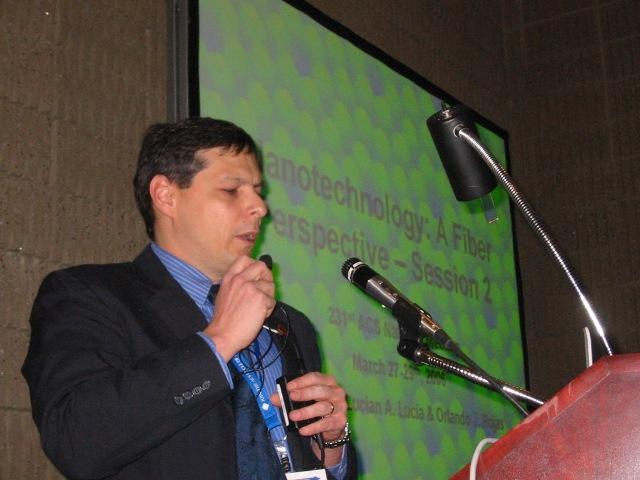
Obtained from: http://www4.ncsu.edu/~ojrojas/
Dr. Orlando Rojas gives a talk on nanotechnology and cellulose nanofibers at a conference.
Paper. To many people, paper is more or less just a medium on which notes are transcribed, newspapers are printed, or packages are shipped. However, here at N.C. State, the Department of Forest Biomaterials is doing research to find other less commonly known uses for this commodity product.
“People tend to disregard the impact of paper in our society, just because it’s a commodity product,” says Dr. Orlando Rojas, professor in the department. “But if you think about the properties of paper and the uses of fiber, it’s really infinite. You can use it to paint, to wear, to hold, to absorb, to carry materials, everything,” he said.
The main focus of Rojas’s lab group is the formation of nanomaterials from cellulose.
“I like cellulose as a polymer because it is widely available, it is around us, it is renewable, and you can essentially do anything you want with cellulose,” Rojas said.
Cellulose, a long chain of sugars that accounts for half of the tree’s chemical makeup, boasts a variety of applications besides the fundamental uses of paper and board. It can be used in additives for cosmetics, as a thickener in ice creams and paints, and in filtration devices. Rojas and his team are currently investigating ways to form aerogels, foams and nanofibers from cellulose in a laboratory setting.
“Foams can be used as an absorbent, for example, diapers, high capacity absorption materials, filtration, for insulation, thermal insulation, noise insulation,” Rojas said. “[Aerogels] are 95% air, yet they have very high mechanical strength. Nanocellulose is a very strong material. The transverse elastic modulus is stronger than carbon nanotubes.”
An aerogel is the solid part of a gel after the liquid solvent is removed, resulting in a very porous, yet strong material, able to support upwards of tens of thousands times its own weight. Aerogels are also very good insulators of heat and sound.
Rojas, originally from Venezuela, did not have anywhere to practice his English until he came to the United States to earn his Ph.D. at Auburn University. “When I went to Stockholm my English was not as bad because compared to the English they spoke over there I felt more even because for them it is also a second language, so I didn’t feel that as a barrier for me,” he said.
Nevertheless, he still feels a lot more comfortable around his native language, Spanish. “I have said that when I give a talk in Spanish, I can stand up on the table and start to dance; I feel completely free. That’s my language,” Rojas said.
For those who are learning a new language, he says to “just let it go, and feel not too conscious about the mistakes you are making…I think the best way is to surround yourself with Hispanics/Spanish speakers…study abroad, it can be a mind changer.”
Rojas came to N.C. State in 2003, and since then has not only led research in the area of nanocellulose, but has also made conscious efforts to reach out to the Hispanic community, and to help undergraduate students as much as possible. Of his 23 researchers, he has representatives from Chile, Venezuela, Colombia, Cuba, Spain, Bangladesh and Finland; in the past he has had students from Brazil as well. Currently he has one undergraduate researcher from N.C. State.
He has also helped with the Society of Hispanic Professional Engineers (SHPE) and encourages Hispanic students to continue with graduate work. “For some years I was the advisor for SHPE…during some time we did some work visiting middle schools to talk about education and there was a group of students that put the time to go to schools and work as mentors for Hispanic students,” Rojas said.
Although much of his time is spent conducting research, making an impact on his students is what he values most. “Being a faculty, that is a great opportunity, because you can change lives… Out of all the people who have worked with me, if I am able to make a positive change [in their life], I think that pays all my efforts,” Rojas said.